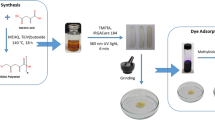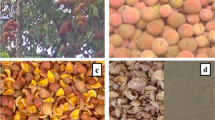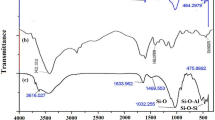Abstract
A novel biodegradable copolymer and nanocomposite with nickel-doped zinc oxide were developed using grafting acrylic acid and vinyl acetate as gelatin backbone in the presence of ammonium persulfate as an initiator. The copolymer and its nanocomposite were formed through free radical polymerization. The prepared copolymer and its nanocomposite were characterized using Fourier Transform Infrared Spectroscopy (FTIR), thermogravimetric analysis (TGA), and Differential Scanning Calorimetry (DSC). The intense bands at 1750 cm−1, 1375 cm−1, 1250 cm−1, and 1050 cm−1in the FTIR spectrum of polymers confirm the grafting of monomers of the gelatin backbone. The TGA analysis indicates that the copolymers were not wholly exhausted up to 500 °C, and adding nanoparticles enhanced the thermal stability. The degradation study revealed a 25.29% and 15.01% weight loss over two months for copolymer and nanocomposite, respectively. Results showed that the initial weight of the copolymer and its nanocomposite increased due to water adsorption and then decreased, as identified by the soil burial method. The copolymer is biodegradable, and the addition of nanoparticles (nanocomposite) increased its shelf life and resistance to soil microbes. The synthesized nanocomposite was evaluated as an adsorbent for methylene blue dye from an aqueous solution. The adsorbent copolymer gelatin-g-poly(vinyl-acetate-co-acrylic acid) with Ni-doped ZnO NPs may prove to be a new route toward pollution control for the removal of methylene blue, having a removal capacity of 521.26 mg/g.
Graphical abstract









Similar content being viewed by others
References
Jensen W (2008) The origin of the polymer concept. J Chem Educ 85:624
Kumar AA, Karthick K, Arumugam KP (2011) Biodegradable polymers and its applications. Int J Biosci Biochem Bioinf 1(3):173
Ching C, Kaplan D, Thomas E (1993) Biodegradable polymers and packaging. Tech Publ Company Lancaster 29:97–110
Shimao M (2001) Biodegradation of plastics. Curr Opin Biotechnol 12:242–247
Petersen K, Nielsen PV, Bertelsen G, Lawther M, Olsen MB, Nilsson NH, Mortensen G (1999) Potential of biobased materials for food packaging. Trends Food Sci Technol 10:52–68
Corcoran PL, Biesinger C, Grifi M (2009) Plastics and beaches: a degrading relationship. Mar Pollut Bull 58:80–84
Derraik JG (2002) The pollution of the marine environment by plastic debris: a review. Mar pollut bull 44:842–852
Guzman A, Gnutek N, Janik H (2011) Biodegradable polymers for food packaging–factors influencing their degradation and certification types–a comprehensive review. Chem Chem Technol 5:115–122
Lazar B, Gračan R (2011) Ingestion of marine debris by loggerhead sea turtles, Caretta caretta, in the Adriatic Sea. Mar pollut bullet 62:43–47
Azzarello MY, Edward S, Van-Vleet ES (1987) Marine birds and plastic pollution. Mar Ecol Prog Ser 37:295–303
Baig A, Zubair M, Zafar MN, Farid M, Nazar MF, Sumrra SH (2022) Nanobiodegradation of plastic waste. Int Biodeterior Biodegr. https://doi.org/10.1016/B978-0-12-823970-4.00011-7
Barreiros JP, Barcelos J (2001) Plastic ingestion by a leatherback turtle Dermochelys coriacea from the Azores (NE Atlantic). Mar Pollut Bull 42:1196–1197
Pathania D, Kalia R (2012) Graft copolymerization of acrylic acid onto gelatinized patato starch for removal of metal ions and organic dyes from aqueous system. Adv Mater Lett 3:259–264
Carraher CE Jr (2017) Introduction to polymer chemistry. CRC Press, Boca Raton
Kim MN, Lee AR (1999) Effect of surface roughness on biodegradability of Poly (3-hydroxybutyrate). Korean J Environ Biol 17:249–255
Negi H, Kapri A, Zaidi GH, Satlewal A, Goel R (2009) Comparative in-vitro biodegradation studies of epoxy and its silicone blend by selected microbial consortia. Int Biodeterior Biodegradation 63:553–558
Shi R, Bi J, Zhang Z, Zhu A, Chen D, Zhou X, Tian W (2008) The effect of citric acid on the structural properties and cytotoxicity of the polyvinyl alcohol/starch films when molding at high temperature. Carbohydr Polym 74(4):763–770
Gu SY, Zhang K, Ren J, Zhan H (2008) Melt rheology of polylactide/poly (butylene adipate-co-terephthalate) blends. Carbohydr Polym 74:79–85
Yang KK, Wang XL, Wang YZ (2007) Progress in nanocomposite of biodegradable polymer. Ind Eng Chem Res 13:485–500
Fabra MJ, Busolo MA, Lopez-Rubio A, Lagaron JM (2013) Nanostructured biolayers in food packaging. Trends Food Sci Technol 31:79–87
Malina D, Sobczak-Kupiec A, Wzorek Z, Kowalski Z (2012) Silver nanoparticles synthesis with different concentrations of polyvinylpyrrolidone. Dig J Nanomater Biostruct 7:1527–1534
Uddin M, Rahman M, Rukanuzzaman M, Islam M (2017) A potential low cost adsorbent for the removal of cationic dyes from aqueous solutions. Appl Water Sci 7:2831–2842
Jiang Y, Liu B, Xu J, Pan K, Hou H, Hu J, Yang J (2018) Cross-linked chitosan/β-cyclodextrin composite for selective removal of methyl orange: adsorption performance and mechanism. Carbohydr Polym 182:106–114
Guleria A, Kumari G, Lima EC (2020) Cellulose-g-poly-(acrylamide-co-acrylic acid) polymeric bioadsorbent for the removal of toxic inorganic pollutants from wastewaters. Carbohydr Polym 228:115396
Sivakumar R, Lee NY (2022) Adsorptive removal of organic pollutant methylene blue using polysaccharide-based composite hydrogels. Chemosphere 286:131890
Kong W, Chang M, Zhang C, Liu X, He B, Ren J (2019) Preparation of Xylan-G-/P (AA-co-AM)/GO nanocomposite hydrogel and its adsorption for heavy metal ions. Polymers 11:621
Benchikh I, Dahou FZ, Lahreche S, Sabantina L, Benmimoun Y, Benyoucef A (2022) Development and characterisation of novel hybrid materials of modified ZnO-SiO2 and polyaniline for adsorption of organic dyes. J Environ Anal Chem. https://doi.org/10.1080/03067319.2022.2107921
Xu R, Jia M, Zhang Y, Li F (2012) Sorption of malachite green on vinyl-modified mesoporous poly (acrylic acid)/SiO2 composite nanofiber membranes. Micropor Mesopor Mat 149:111–118
Yuan Z, Wang J, Wang Y, Liu Q, Zhong Y, Wang Y, Guo X (2019) Preparation of a poly (acrylic acid) based hydrogel with fast adsorption rate and high adsorption capacity for the removal of cationic dyes. RSC Adv 9:21075–21085
He Y, Bao W, Hua Y, Guo Z, Fu X, Na B, Liu H (2022) Efficient adsorption of methyl orange and methyl blue dyes by a novel triptycene-based hyper-crosslinked porous polymer. RSC adv 19:5587–5594
Sultan M, Nagieb ZA, El-Masry HM, Taha GM (2022) Physically-crosslinked hydroxyethyl cellulose-g-poly (acrylic acid-co-acrylamide)-Fe3+/silver nanoparticles for water disinfection and enhanced adsorption of basic methylene blue dye. Int J Biol Macromol 196:180–193
Abdelhamid AE, Kandil H (2022) Facile approach to synthesis super-adsorptive hydrogel based on hyperbranched polymer for water remediation from methylene blue. React Funct Polym 177:105312
Alibak AH, Khodarahmi M, Fayyazsanavi P, Alizadeh SM, Hadi AJ, Aminzadehsarikhanbeglou E (2022) Simulation the adsorption capacity of polyvinyl alcohol/carboxymethyl cellulose based hydrogels towards methylene blue in aqueous solutions using cascade correlation neural network (CCNN) technique. J Clean Prod 337:130509
Chandran M, Asyraf Wan Mahmood WM, Omar FN, Lazim AM (2022) Removal of methylene blue from aqueous solution using modified polystyrene-calixarene (PS-C) composite. WAT AIR AND SOIL POLL 233:1–11
Chen Y, Li Q, Li Y, Zhang Q, Huang J, Wu Q, Wang S (2020) Fabrication of cellulose nanocrystal-g-poly (acrylic acid-co-acrylamide) aerogels for efficient Pb (II) removal. Polymers 12:333
Tian H, Zhou H, Fu H, Li X, Gong W (2020) Enhanced electrical and dielectric properties of plasticized soy protein bioplastics through incorporation of nanosized carbon black. Polym Compos 41:5246–5256
Jiménez-Rosado M, Alonso-González M, Rubio-Valle JF, Perez-Puyana V, Romero A (2020) Biodegradable soy protein-based matrices for the controlled release of zinc in horticulture. J Appl Polym Sci 137:49187
Ranjbarha Z, Aliabad JM, Aberoomand-Azar P, Mirmohammadi SA, Saber-Tehrani M (2021) Effective Adsorptive Removal of Methylene Blue from Water Using Wood-Plastic Composite Containing High Density Polyethylene and Wood Particles.
Gök MK, Özgümüş S, Demir K, Cirit Ü, Pabuccuoğlu S, Cevher E, Bacınoğlu S (2016) Development of starch based mucoadhesive vaginal drug delivery systems for application in veterinary medicine. Carbohydr Polym 136:63–70
Liufu SC, Xiao HN, Li YP (2005) Thermal analysis and degradation mechanism of polyacrylate/ZnO nanocomposites. Polym Degrad Stab 87:103–110
Soleimani F, Sadeghi M, Shahsavari H (2012) Graft copolymerization of gelatin-g-poly (acrylic acid-co-acrylamide) and calculation of grafting parameters. Indian J Sci Technol 5:2041–2046
Turco R, Zannini D, Mallardo S, Dal Poggetto G, Tesser R, Santagata G, Di Serio M (2021) Biocomposites based on poly (lactic acid), Cynara Cardunculus seed oil and fibrous presscake: a novel eco-friendly approach to hasten PLA biodegradation in common soil. Polym Degrad Stab 188:109576
Surip SN, Wan Jaafar WNR, Azmi NN, Anwar UMK (2012) Microscopy observation on nanocellulose from kenaf fibre. Open J Adv Mater Res 488:72–75
Matavuly M, Molitoris HP (2016) In vitro degradation of poly [(r)-3-hydroxybutyrate] and BIOPOL™ by marine-derived fungi. Biologia Serbica 37:1–2
Maruthapandi M, Kumar VB, Luong JH, Gedanken A (2018) Kinetics, isotherm, and thermodynamic studies of methylene blue adsorption on polyaniline and polypyrrole macro–nanoparticles synthesized by C-dot-initiated polymerization. ACS Omega 3:7196–7203
Ayad MM, El-Nasr AA, Stejskal J (2012) Kinetics and isotherm studies of methylene blue adsorption onto polyaniline nanotubes base/silica composite. Ind Eng Chem Res 18:1964–1969
Minisy IM, Salahuddin NA, Ayad MM (2019) Chitosan/polyaniline hybrid for the removal of cationic and anionic dyes from aqueous solutions. J Appl Polym Sci 136:47056
Iqbal S, Nadeem S, Javed M, Alsaab HO, Awwad NS, Ibrahium HA, Mohyuddin A (2022) Controlled preparation of grafted starch modified with Ni nanoparticles for biodegradable polymer nanocomposites and its application in food packaging. MRT 85:2331–2337
Karimi M, Biria D (2019) The promiscuous activity of alpha-amylase in biodegradation of low-density polyethylene in a polymer-starch blend. Sci Rep 9:1–10
Gull N, Islam A, Ghaffar A, Jabeen S, Iqbal SS, Khan SM, Bilal M (2021) Development and characterization of chitosan and acrylic acid-based novel biodegradable polymeric films for soil conditioning. Int J Biol Macromol 182:950–958
Ahmad K, Shah HR, Ahmad M, Ahmed M, Naseem K, Riaz N, Ahmad Z (2022) Comparative study between two zeolitic imidazolate frameworks as adsorbents for removal of organoarsenic, As (III) and As (V) species from water. Braz J Anal Chem 9:78–97
Ahmad K, Khan MS, Iqbal A, Potrich E, Amaral LS, Rasheed S, Ashfaq M (2022) Lead In drinking water: adsorption method and role of zeolitic imidazolate frameworks for its remediation: A review. J Clean Pro 368:133010
Fallatah AM, Shah HUR, Ahmad K, Ashfaq M, Rauf A, Muneer M, Babras A (2022) Rational synthesis and characterization of highly water stable MOF@ GO composite for efficient removal of mercury (Hg2+) from water. Heliyon 8:e10936
Naseem K, Ali F, Tahir MH, Afaq M, Yasir HM, Ahmed K, Habila MA (2022) Investigation of catalytic potential of sodium dodecyl sulfate stabilized silver nanoparticles for the degradation of methyl orange dye. J Mol Struct 1262:132996
Jayaramudu T, Pyarasani RD, Akbari-Fakhrabadi A, Abril-Milan D, Amalraj J (2021) Synthesis of gum acacia capped polyaniline-based nanocomposite hydrogel for the removal of methylene blue dye. J Polym Environ 29:2447–2462
Singh J, Dhaliwal AS (2021) Effective removal of methylene blue dye using silver nanoparticles containing grafted polymer of guar gum/acrylic acid as novel adsorbent. J Polym Environ 29:71–88
Yan B, Chen Z, Cai L, Chen Z, Fu J, Xu Q (2015) Fabrication of polyaniline hydrogel: synthesis, characterization and adsorption of methylene blue. Appl Surf Sci 356:39–47
Ren F, Li Z, Tan WZ, Liu XH, Sun ZF, Ren PG, Yan DX (2018) Facile preparation of 3D regenerated cellulose/graphene oxide composite aerogel with high-efficiency adsorption towards methylene blue. J Colloid Interface Sci 532:58–67
Aoopngan C, Nonkumwong J, Phumying S, Promjantuek W, Maensiri S, Noisa P, Srisombat L (2019) Amine-functionalized and hydroxyl-functionalized magnesium ferrite nanoparticles for Congo red adsorption. ACS Appl Nano Mater 2(8):5329–5341
Labena A, Abdelhamid AE, Husien S, Youssef T, Azab E, Gobouri AA, Safwat G (2021) Grafting of acrylic membrane prepared from fibers waste for dyes removal: methylene blue and Congo red. Separations 8(4):42
Abdelhamid AE, El-Sayed AA, Khalil AM (2020) Polysulfone nanofiltration membranes enriched with functionalized graphene oxide for dye removal from wastewater. J Polym Eng 40(10):833–841
Author information
Authors and Affiliations
Corresponding authors
Ethics declarations
Conflict of interest
There is no known competing financial and personal interest relevant to this work.
Additional information
Publisher's Note
Springer Nature remains neutral with regard to jurisdictional claims in published maps and institutional affiliations.
Rights and permissions
Springer Nature or its licensor (e.g. a society or other partner) holds exclusive rights to this article under a publishing agreement with the author(s) or other rightsholder(s); author self-archiving of the accepted manuscript version of this article is solely governed by the terms of such publishing agreement and applicable law.
About this article
Cite this article
Amjad, M., Mohyuddin, A., Nadeem, S. et al. Development of biodegradable vinyl acetate and acrylic acid grafted gelatin copolymer for dye adsorption. Polym. Bull. 81, 1453–1469 (2024). https://doi.org/10.1007/s00289-023-04782-w
Received:
Revised:
Accepted:
Published:
Issue Date:
DOI: https://doi.org/10.1007/s00289-023-04782-w




